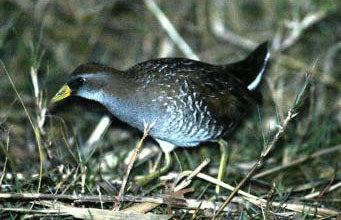SCIENTIFIC NAME:
PORZANA CAROLINA
STATUS:
Fairly common in winter, spring, and fall in Gulf Coast region. In Mountain and Inland Coastal Plain regions, uncommon in winter and uncommon to rare in spring and fall. In Tennessee Valley region, uncommon to rare in spring and fall. Low Conservation Concern.
DESCRIPTION:
Soras are small grayish-brown birds with a plump build. They have a short yellow bill and a black mask on the face and throat. The remainder of the neck and breast are ashy-gray; flanks are a darker gray with white barring; legs are green. Total length ranges from eight to ten inches and weights average two to four ounces. Plumages of males and females are similar. Females are slightly smaller than males and have darker colored bills. The black on the head of the female is duller and less extensive. Females also have a gray ear patch that extends unbroken from the eye to the nape of the neck. The ear patch on males is usually discontinuous with the gray of the nape and may or may not extend to the eye. Vocalizations include a high-pitched descending “whinny”, a whistled “kerwee”, and a variety of short, sharp, “keek” calls.
DISTRIBUTION:
The sora is the most abundant and widely distributed rail in North America. Soras breed from Nova Scotia, New Brunswick, and Prince Edward Island and west through the St. Lawrence Valley and Ontario to northern Saskatchewan and Alberta, southern Mackensie and central British Columbia, south to central California, and east to central Colorado and Kansas, northern Missouri, Ohio, and Maryland. Winter distribution is dictated by an apparent intolerance for freezing temperatures. Soras winter from the southern United States, Mexico, and Central America south to Peru, Guyana and the West Indies. In the U. S., wintering populations are found from the Chesapeake Bay south through Florida, and west to Louisiana, Texas, southern Arizona, and central California. Wintering populations extend into much colder regions along the Rio Grande into Colorado and up the Colorado River into Arizona. Power plants along these rivers may be discharging warm water, preventing adjacent wetlands from freezing.
HABITAT:
Soras inhabit wetlands dominated by emergent vegetation. Preferred wetlands are fresh water marshes, though ocassionally Soras nest in salt marshes. During migration they are often found in brackish and salt marshes.
FEEDING HABITS:
Soras eat a variety of plant materials and invertebrates. Plant material is a major component of the diet during summer and fall. Commonly consumed plants are duck weed, smartweed, sedges, grasses, and seeds of wild and cultivated rice. Fall migrants in salt marshes may feed more heavily on invertebrates, including grasshoppers, crickets, and larval cases of moths.
LIFE HISTORY AND ECOLOGY:
Soras arrive on the breeding grounds from April through May and eggs are laid from April to June or May to July, depending on the region. Nests are loosely woven baskets of available vegetation, constructed over standing water, usually in sedges or cattails. Nests may be supported by stems of vegetation or built in a solid mass within a clump of vegetation. Nests often have a ramp to the lip of the nest. Dummy nests are often built near by and serve as resting platforms. Clutch size is 5 to 15 with an average of ten eggs. Incubation lasts about 14 days but almost twice that time is required to hatch all eggs since incubation begins when the clutch is partially complete. Both sexes incubate, brood, and feed the young. Males defend the well-defined nesting and brood rearing territories. During the hatching period, one adult continues to incubate while the other remains nearby with the incomplete brood. Young quickly become mobile on land and in the water but are semi-dependent on parents for feeding and are brooded for about one month. Soras are reared to independence as family groups within nesting territories. Chicks can fly at four weeks of age
REFERENCES:
Tacha, Thomas C., Clait E. Braun, eds. 1994. Migratory Shore And Upland Game Bird Management In North America. 223 pp.
AUTHOR:
Bruce Todd, Wildlife Biologist, Division of Wildlife and Freshwater Fisheries






